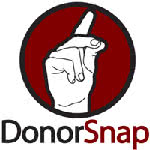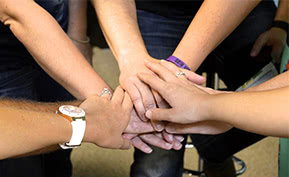Nonprofit Donor Management
Let's Talk DonorSnap: Behind the Software with Co-Founder Dennis Mueller

Nonprofits require specialized products to address their range of financial, marketing and client relationship management needs. Yet oftentimes these industry-specific solutions are unreasonably priced for the companies that need them most: charities with minimal personnel operating on tight budgets. We talked to Dennis Mueller, co-founder of DonorSnap, about how the company got its start, his exasperation with the layered pricing models of other specialized nonprofit solutions, and why he was such a stickler about DonorSnap’s simplistic pricing plan.
How did DonorSnap come about?
WEBSITE: www.donorsnap.com
LAUNCHED: 2007
LOCATION: Milwaukee, WI
CUSTOMERS: Mount Tabor Center, Land of Lakes Choirboys, Trinity Christian School
After my wife and I built a nonprofit [Malaika Early Learning Center], we spent about a 5-year period going through the trials and tribulations of trying to find software that worked for us. Our development director suggested Raiser’s Edge — and nothing against Raiser’s Edge because it’s a phenomenal product — but it ended up being too complicated for our needs. When we changed development directors and couldn’t figure out how to use it, we decided to switch. Then we did what many do: we began using an Excel spreadsheet, which was overly unwieldy.
Because of my IT background, I decided to write a door management trust to use. It was intended just for Malaika, and that worked for about 2 years until it was no longer workable for me to easily get the information I needed. That’s when I started looking for another software program. There were packages out there, but the pricing model was what turned me off because I knew that it didn’t cost more whether 2 or 3 people were using it. Everybody’s pricing model was a layered pricing model with ultimate costs dependent on the number of users. That’s when we decided to write our own.
What really drove us to build DonorSnap was that I didn’t like the available pricing models and figured we could do better by creating our own product. I had my programmers from the internet-based construction company I owned build the software because they were well-versed in writing internet products. Our products in the construction company were used by guys who didn’t really know how to use computers, so we wrote DonorSnap to be a very intuitive product with simple pricing.
How does DonorSnap stand out from other donor management platforms available to nonprofits?
I would say pricing, intuitiveness and simplicity — our focus on simplicity is really the hallmark of the product. Whenever we look at development, there are a lot of great features you can add, but the discussion is always is that going to benefit 2 people and confuse 200 people?
And of course DonorSnap is not for everybody. We try to be upfront that simplicity is what we do and we do it well; you may have a unique feature that we just can’t accommodate. We don’t try to fit a square peg into a round hole.
What industries or types of nonprofit organizations does DonorSnap work best for?
It’s really more about how the organization wants to function and its size than the specific type of nonprofit. We work with a range of different niches: everything from special arts schools and humane societies to small animal rescue societies. On the other hand, we don’t work well for somebody with a storefront operation wanting to sell products. We don’t accommodate that kind of a product service with catalog, inventory and all of that. Also, if you have an in-house development staff of 4 or 5 people, you are going to morph up to a product like Raiser’s Edge because the features for tracking complex interrelationships in Raiser’s Edge are phenomenal.
Why is it worthwhile for nonprofit organizations to invest in a solution like DonorSnap that’s built for nonprofits?
Speaking from experience on the board of my nonprofit, development becomes the life-blood of the organization, but it’s the piece that a lot of people don’t want to do. You need an organized approach to knowing who is giving you money, when they give it to you and whether you’ve followed up. If you don’t acknowledge when people have given gifts in a timely manner, that turns off the donor. When I get 3 mailings with my name spelled 3 different ways from the same nonprofit, I know that there is no connection between that nonprofit and me — they just want my check.
Getting a donor management system and using it really helps you connect with and reach your donors in a timely, quick response, and it also lets you know what’s going on. If you don’t have a system, you won’t realize when somebody who used to give hasn’t given for 4 years because you lost track of them. At one point in time they were invested in your mission, and they drifted away for a reason. For you never to even to have asked them is a kind of cardinal sin for the executive director or the board of a nonprofit.
Why don’t traditional CRM solutions and other general-purpose software suffice for nonprofits?
The traditional CRM is designed to handle the sales funnel process. Where it falls short is that the CRM was never designed to be a donation management system. CRM systems are conceptually no different than nonprofit software, but they focus on the front end of getting customers in the door, while donor management products are written to not only track who’s out there but also where they’re at after the fact.
In donor management the acknowledgment letter is built-in, it’s not an afterthought or an add-on. Tracking those who gave last year but not this year, the life donations, the ability to stratify your donation between campaigns, appeals, different accounting funds, honorariums, memorials, pledges — those functions weren’t built into any of the CRMs initially. The CRM must be adapted to handle the functions that donor management needs.
On the other side, accounting systems are great at historical, but they were never designed to manage donors. What you want in a donor management straddles right between accounting and the CRM. You’ve got the historical component, which is in your donor history system, and you’ve got the CRM component for mining your data and sending out your campaign and field letters.
A lot of nonprofits are attracted to the CRM because of the free editions, but many end up getting frustrated because although free, it’s complicated. That complication has a price because they don’t end up using it. It’s not a money toll, but its effect is the same. The other side of the coin is people try to use QuickBooks, which is great for accounting, but not designed for needs like campaign letters and attribute tracking. Nonprofits lean toward general software because their budgets are low, basic CRM is free or they already have QuickBooks in an effort to try to conserve resources. A lot of times I think that they pay a price for doing that and hurt themselves in the long run.
Your platform is one of the most affordable and comprehensive donor management solutions available, which is why we’ve recognized it as one of three finalists in our Best Value series for the Nonprofit Management category. What challenges have you faced while trying to perfect this balance of cost and functionality?
We have a luxury that a lot of our competitors didn’t have — the cost for our product was set before the software was even done. That became a mandate for me that the pricing would not change, now go build a product and a business that can sustain that. Unlike the traditional approach, my business partner and I both have several businesses, and DonorSnap became a hobby that we could do together. There was no initial pressure to make money–it was about building a good business, and building it with a good price model.
The nonprofit software industry seems to be experiencing incredible growth as of late, with general accounting and CRM solutions building nonprofit-specific modules. Have you adjusted your company strategy to address these changes, and if so, how?
No, because our initial strategy was to build a really good product and out-service our competitors, and we very consistently have been doing that. One of the big areas that everybody misses and that we’re very good at is the data conversion aspect. I would venture nobody can touch us as far as collecting a client’s data, creating order out of the chaos and getting it into the system. Robert [Carr] and I really worked on how to use the systems and tools that we developed to take data from many different forms and get it loaded. I think we can do that better than anybody, so at least for the next couple of years that will still be our competitive edge.
What trends have you noticed in the donor management industry lately that users should look out for?
The one feature that’s starting to come on strong now is integration of form development. Not just the donate now button, but creating custom forms that embed into your website for different reasons like data collection. We’re seeing the advent of online and social media tools that let people develop registration forms now become that first contact donors have with your organization.
Learn more about DonorSnap and their nonprofit donor management product at www.donorsnap.com.
If you’d like to learn more about DonorSnap or other nonprofit solutions, you can review a range of solutions in our free Top 15 Nonprofit Donor Management Software comparison report. The Nonprofit Software section of the Business-Software.com blog offers additional information and product reviews of top nonprofit solutions, or you can search our software product directory to browse our entire catalog of software for nonprofits.





